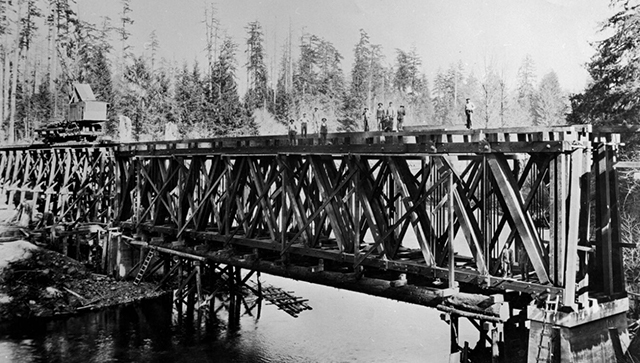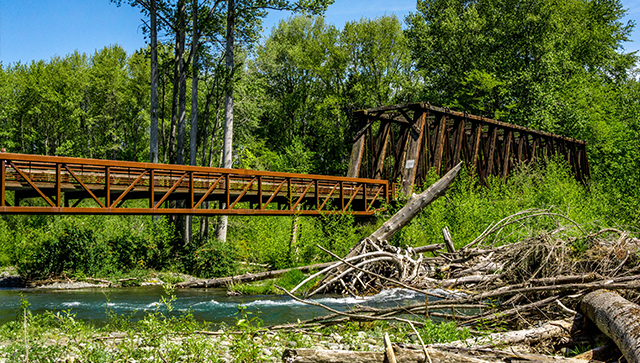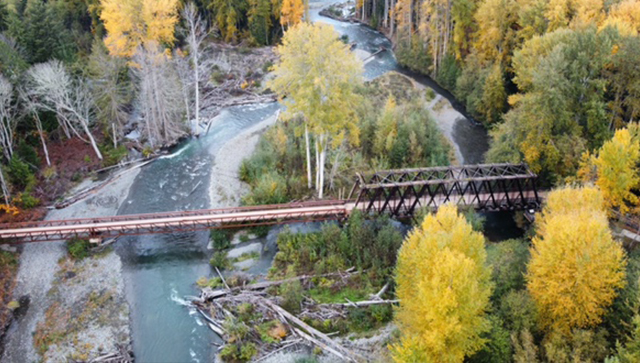Dungeness Railroad Bridge
History of the Bridge
Grading for the the Railroad Bridge and the railroad bed started in January 1914, from the west side of the river with equipment and materials brought by ships and barges to Port Angeles.
The Chicago, Milwaukee, and St Paul Railway, later called the Milwaukee Road, built the bridge. The timber for the bridge was cut at railroad saw mills maybe in the northwest but possibly in the Midwest. The iron jigs used to size and bore the timbers and the steel for the bridge were likely made in railroad yards and foundries near Chicago, IL.
Making and building the the bridge took about 3-4 weeks in the summer of 1915. The lower timbers (stringers) were assembled first and set to grade on pieces of timber to support their weight. Then the rails were laid. A train could then carry the heavy timbers for the vertical parts of the bridge, which were lifted and bolted into place directly from flat cars. Then the cribbing was removed. The bridge first carried trains in July, 1915.

Port Angeles Western Elwha River Bridge
From 1915 to 1980 the Milwaukee Road operated the rail line from Port Townsend to Port Angeles and then west to connect with several logging railroads. The overwhelming cargo carried by the railroad was Olympic Peninsula timber. The line did operate a passenger service until the 1930’s. The Milwaukee Road sold the line to the Seattle and North Coast Railroad in 1980 who, in-turn, abandoned the line in 1985. The last train crossed the bridge in March, 1985.
Foot note:
The history of our region and the railroad is interwoven with that of the bridge. Most of the information in this summary comes from the research of John Hook and Steve Hauff. These two men have made a lifelong commitment to researching, recording, and saving the history of the railroads in western Washington. Any mistakes in this summary, however, are mine. If anyone has more questions on the bridge or the railroad, we have more detailed information at the River Center.
Image from Washington Rural Heritage, the Community Digital Archives for Washington State.
Design of the Bridge
The bridge is a modified Howe-through truss. This means that the train went through the middle of the structure of the truss.
The designer of the truss was a millwright from Spencer, Massachusetts, named William Howe, who was also the uncle of Elias Howe, the inventor of the sewing machine. The first Howe truss was built in 1838 near Warren, MA. Howe was more of an inventor than an engineer, as he personally supervised the construction of only two of his trusses.
William’s major innovation over earlier wood trusses was the use of iron (later steel) to carry the tension load and wood to carry the compression load. On our bridge there are sets of vertical steel rods on each side that carried the tension, or stretching force, that was exerted by the weight of the train as it went over the bridge. The cheaper and more plentiful timbers supported the compression, or squeezing force, that occurred as the weight of the train shifted through the structure as it rolled down the tracks.

Modified Howe-through truss
Many railroads quickly adopted this design as a standard railroad structure. It was stiff, relatively inexpensive, very suitable for trains, and could be “prefabricated;” that is, cut to size in a mill or at an off-site shop and hauled to the site by the railroad. It could be erected quickly by a crew of railroad construction workers, not requiring a higher-skilled group of iron/steel workers, as did iron/steel trusses.
The Howe truss was used by US railroads for over 130 years from 1850’s -1980’s. It was common in the West and particularly in the Northwest. While the timber was plentiful in the Northwest compared with iron and steel, all the materials were usually processed in the east or mid-west then hauled here on the railroads. Since the railroad hauled its own materials, the cost of transportation was a minor factor.
Most Howe trusses in the Northwest were built after 1880. Our Howe truss, built in 1915, was one of the last built in Washington and is one of the few remaining. It might even be the last! It is on the National Historic Register.
Bridge Sections & Length
There are two sections of our bridge: the truss part, which is the primary span over the main stem of the River, about 150 feet long; and the trestle part, which is the long wood walkway supported by pilings and short timber beams/stringers, about 580 feet long. The trestle section of the bridge lies over the western flood plain and several side channels of the river, allowing flood waters to flow past the bridge with little restriction. The total length of the bridge, truss plus trestle, is over 730 ft. long; making our Railroad Bridge the longest bridge on the Dungeness River.

Foot note:
On February 6, 2015, a large flood washed out several pilings supporting the historic trestle west of the main bridge. The damage was significant enough to close the bridge and trestle for the next 10 months. As part of the repair, the park partnership decided it was a good time to remove all the pilings containing unhealthy creosote that supported the trestle. The Jamestown S’Klallam Tribe secured funding and contractors for the project, leading to construction of a new, environmentally-friendly trestle. The historic truss part of the main bridge remained unchanged, other than replacing its old rotting wooden deck with a concrete deck. The rebuilt trestle with concrete supports and a new deck reopened to foot traffic on December 30, 2015.
Railroad Landmark Tour
Follow the route to see the bridges, trestles, rails, and trails

